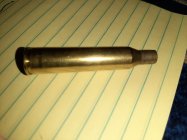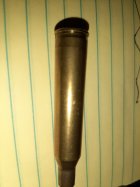never had/have hard extracting with bumping shoulders.... and don't hot rod loads, so the case really doesn't expand that much. Two grains below max prevents excess pressure, excess stretching.
You are using an out of date browser. It may not display this or other websites correctly.
You should upgrade or use an alternative browser.
You should upgrade or use an alternative browser.
Extraction issues
- Thread starter codybrown
- Start date
wkdickinson
Gold $$ Contributor
I had a lesson in that when I bought a used Savage 243 built on a Savage "target" action a few years ago. It came with a quantity of Lapua brass (fired 3-4 times) and a Forster Neck die. I had a terrible time getting the bolt open no matter how hot (or not hot) the loads were. Did lots of research, found that Savages often have "primary extraction" issues. Tried all kinds of things, finally some one on here mentioned that I should try full length resizing. I bought a new Redding Type-S FL bushing die and haven't had a problem since. I sold the neck die and will never not FL resize again.In my experience partial full length sizing is an exercise in futility -as is neck sizing only. I want my bolt to close with little resistance and open freely without resorting to a death grip over the scope tube with my thumb. I full length size every time- when the brass starts giving problems it gets scrapped. I prefer not to abuse my lugs and cocking cams just to get an extra cycle or two out of brass .
I had a barrel that wasn't marked years ago, no issues.
Me personally.... for my hunting rifles, I always full length. Used my father in laws lever M88 one year, and he was hot about neck sizing. I told him I had hard extraction, and I knew why, but he gave me an attitude, like yeah so? What good is it to have a repeater, with this problem? I learned right there to Full length, yes, but eventually I learned about Partial FL, and with the right gauges, it can be done right. And as long as you keep track of what your doing, notes taking on loads, for the next time, Partial FL isn't a problem. .002 to .003 thou is pleanty for no issues, especially if you use a slower burning powder with the right bullet weight.I had a lesson in that when I bought a used Savage 243 built on a Savage "target" action a few years ago. It came with a quantity of Lapua brass (fired 3-4 times) and a Forster Neck die. I had a terrible time getting the bolt open no matter how hot (or not hot) the loads were. Did lots of research, found that Savages often have "primary extraction" issues. Tried all kinds of things, finally some one on here mentioned that I should try full length resizing. I bought a new Redding Type-S FL bushing die and haven't had a problem since. I sold the neck die and will never not FL resize again.
wkdickinson
Gold $$ Contributor
I'm glad it works for you, but why would you "partial FL resize", I don't get what you think the advantage to that is? I am not new to reloading at all, been doing it for 45 years. I have neck sized in the past for my 308 Win match rifle and it worked fine, or so I thought. However today, I don't think the risk of issues in a match, merit what little is gained. But now I also anneal before each reloading, bump the shoulder back .002" and final size the neck with a mandrel.Me personally.... for my hunting rifles, I always full length. Used my father in laws lever M88 one year, and he was hot about neck sizing. I told him I had hard extraction, and I knew why, but he gave me an attitude, like yeah so? What good is it to have a repeater, with this problem? I learned right there to Full length, yes, but eventually I learned about Partial FL, and with the right gauges, it can be done right. And as long as you keep track of what your doing, notes taking on loads, for the next time, Partial FL isn't a problem. .002 to .003 thou is pleanty for no issues, especially if you use a slower burning powder with the right bullet weight.
This is sound advice - I would like to add that in my experience of loading literally thousands of center fire rifle cartridges for many years, full sizing done properly, does not reduce case life or degrade accuracy.In my experience partial full length sizing is an exercise in futility -as is neck sizing only. I want my bolt to close with little resistance and open freely without resorting to a death grip over the scope tube with my thumb. I full length size every time- when the brass starts giving problems it gets scrapped. I prefer not to abuse my lugs and cocking cams just to get an extra cycle or two out of brass .
Never heard it called “partial” full length sizing. Basically it’s setting up your dies to bump the shoulder back just enough to easy bolt closure. Usually .002-.003.
A lot of times if you setup your dies as to the the manufacturers instruction with cam over , it will oversized your brass leading to case-head separation and reduced brass life.
A lot of times if you setup your dies as to the the manufacturers instruction with cam over , it will oversized your brass leading to case-head separation and reduced brass life.
in two words? case life.....unless you know a fountain deep and wide with reloading components.I'm glad it works for you, but why would you "partial FL resize", I don't get what you think the advantage to that is? I am not new to reloading at all, been doing it for 45 years. I have neck sized in the past for my 308 Win match rifle and it worked fine, or so I thought. However today, I don't think the risk of issues in a match, merit what little is gained. But now I also anneal before each reloading, bump the shoulder back .002" and final size the neck with a mandrel.
Have you compared case life using both methods? Partial full length sizing is what is called "counter-intuitive"; that is one would think working the brass minimally and only full length sizing only when bolt operation becomes difficult would extend brass life. In his book "Extreme Rifle Accuracy" Mike Ratigan contends that is not the result of his trials. If the FL die matches closely with the chamber the brass will last longer and be less problematic by FL sizing every time. I don't have the book to quote but I believe it has to do with inconsistencies from allowing the brass to expand incrementally (partial sizing) and then full sizing it - the dimension change is more drastic vs. full sizing every time.in two words? case life.....unless you know a fountain deep and wide with reloading components.
If you have a system that works then stick with it. I prefer to keep reloading as simple as possible and whether hunting or competition, fighting case issues is a must to avoid.
Tommie yeah I hear ya..
Last edited:
codybrown
Silver $$ Contributor
Got the bolt back today and did some testing with brass I've shot in the rifle. Appears to be an issue near the case head where there is an obvious mark where the die stops.
A piece of 1x fired factory brass measures .4405 and chambers effortlessly. 5 pieces that chamber difficultly that have been full length revised and the fired measure .4425 - .4430
A piece of 1x fired factory brass measures .4405 and chambers effortlessly. 5 pieces that chamber difficultly that have been full length revised and the fired measure .4425 - .4430
Attachments
Similar threads
- Replies
- 8
- Views
- 5,058
Upgrades & Donations
This Forum's expenses are primarily paid by member contributions. You can upgrade your Forum membership in seconds. Gold and Silver members get unlimited FREE classifieds for one year. Gold members can upload custom avatars.

Click Upgrade Membership Button ABOVE to get Gold or Silver Status.
You can also donate any amount, large or small, with the button below. Include your Forum Name in the PayPal Notes field.
To DONATE by CHECK, or make a recurring donation, CLICK HERE to learn how.

Click Upgrade Membership Button ABOVE to get Gold or Silver Status.
You can also donate any amount, large or small, with the button below. Include your Forum Name in the PayPal Notes field.
To DONATE by CHECK, or make a recurring donation, CLICK HERE to learn how.











